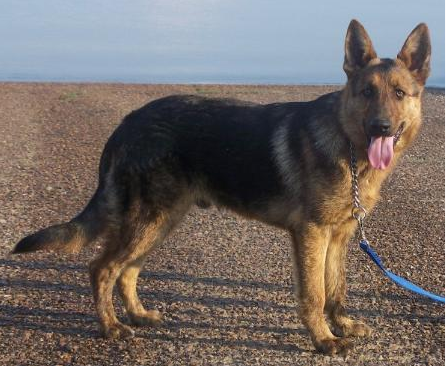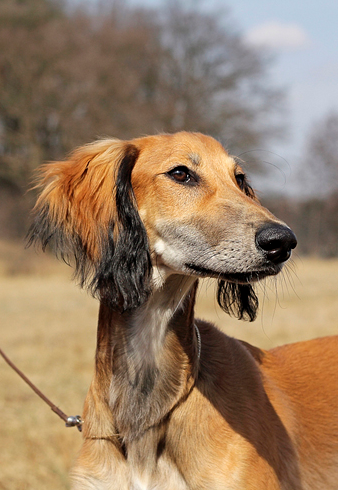
This is a placeholder text
Group text
by GSDlovergirl on 17 October 2012 - 09:10

Konig Bondo Des Geistfeue
http://www.pedigreedatabase.com/dog.html?id=452944
You guys may have seen this dog before as I believe he's been used in other posts. However, could someone explain the oddity of his markings particularly the hind-quarters which are "strippish" when he comes from a line of obvious black & tans. I went back to the 1980s and what dogs do have photos are clear marked black & tans... no where near what he looks like.
The K gene acts as this: K [black], kbr [brindle] and k [non-solid].
Agouti series is: ay [clear sable - not present in GSDs], aw [agouti/sable], as [saddled], at [tanned], a [recessive black]
And then there's odd mutations. Dominant black is found to be a mutation of the K gene... so it is possible GSDs might be carrying some sort of yet undiscovered gene.

http://pawvillage.com/pedigree/dynprofile.asp?ID=2Z1F82BJ7E
Pup's photos http://www.arabica.net.pl/fourweeks.html
The saluki above is showing off a sooty mask. An as yet unexplained Em trait where pups will be born to entirely maskless parents with a vague masked impression.
Similarly clubs make mistakes.
There is and has been some misinformation on brindles, including some coming from the AKC. For years the AKC Dog Book had a statement that the first Sheltie registered in the United States was Lord Scott, a golden brindle. Right dog, wrong color - Lord Scott was registered (in 1911) as a sable. Unfortunately the error propagated onto the AKC web page on Shelties, though it has now been corrected online.
http://bowlingsite.mcf.com/genetics/Brindle.html
So it is more than possible, as exemplifed many times, that brindle exists just that it's unspoken of.
by vonissk on 17 October 2012 - 12:10
A couple of comments here. I have read every post but I don't understand the big deal with the wavy stripe down their back. 2 of my puppies have it and so does their mom. I thought it was just a common thing--BTW they are all black.
Now the book I am reading/studying is a reprint from 1938 by Elliot Humphrey, the trainer at Fortunate Fields in Switzerland. When he explains about the breeding charts they kept, he makes reference to brindles and whites and how they were noted. He says nothing about any other colors referenced like that. So that tells me that they considered these off colors. There are mega old pics in there and I see nothing even faintly resembling a brindle and definately no whites.
Again my beliefs on the black gene. IF the GSD carried a dominant black gene then why does it still take 2 black carriers to make black puppies? I believe someone said in this thread well things have changed a lot. Research might have changed, etc. but evidently the dogs don't know that because in our little corner of the world all our dogs are either black or carry the black recessive and it still takes 2 to make a black puppy. As far as lines, that doesn't matter. As most of you know my favorite reference to them is our mutts because of the mixed lines..................
by BlackthornGSD on 17 October 2012 - 18:10
I agree that this dog Konig (http://www.pedigreedatabase.com/dog.html?id=452944) appears brindle. So, looking at his ancestry, please tell me how those generations "hid" the brindle gene for so long? If they were Kb, then there would be a line of parents who were solid black in appearance. If they were Kbr, there would be a line of brindles in the pedigree. Even saying some of those ancestors carried the recessive for black, how would this hide the Kbr gene? I think it's far more likely that the brindle on Konig is either a mutation of some sort (chimera? some other mutation?) or one of his ancestors is not as shown on the pedigree--as in, not really an ancestor, that is, that one of his parents was a brindle-carrying non-GSD.
Christine
by vonissk on 17 October 2012 - 18:10
Thank you Christine. Not to be a wise azz or anything but this post is th first one I really really understand--in other words it is written in plain enough english and making reference to simple genetics..............
I agree with you about being suspicious of a brindle introduced somehow and the dominant black also.
I have this little booklet printed by Purina in about 1960--one of those simple things about caring for your dogs and a little about each breed. One of te thigs I thought was strange was brindle is listed in this booklet as an accepted color for the GSD. I posted that once on here and someone said they wouldn't believe anything Purina said. But I still found it interesting.
That girl at that K9 Pines place that supposedly has the purebred brindles--another thing I find strange about her is she has never put up a pedigree of this supposed purebred brindle gsd. If something like that popped up in a litter I bred I would be networking with people trying to figure this all out. But when you breed all the "colors" then I guess it makes no difference. My guess is like I was talking about the book I am studying and how he referred to making notes about any brindls or whites being born in the litter that they were culled. My guess is most people weren't that impressed with them--likely we will never truly know when the last ones were born, etc. because they were culled.
by BlackthornGSD on 17 October 2012 - 19:10
Solid white also hides the agouti patterns, so you could have a dog who was carrying all sorts of undesirable color elements, such as white feet, white blazes, fading saddles and masks and so on, without knowing that the dog carried those markings. So the breed club decided to eliminate the white color. It's not a color that can be selected for and also interbred with the rest of the breed without causing undesirable traits to show up in the other colored dogs. In contrast, the recessive black genes generally enhance the saddle markings and reduce fading--so it was a color that was allowed and kept in the breed.
Christine
by Elkoorr on 17 October 2012 - 19:10
by Elkoorr on 17 October 2012 - 19:10
by vonissk on 17 October 2012 - 22:10
Elkoor thanks for explaining that about the waves. I didn't take it to mean brindle was involved--I just wasn't sure whether it was just a refernce or what. I'm not sure about the Erich dog but I can tell you she is linebred on Trommel lines and she also carries Erlenbusch, Stadfeld, Haus Larwin. von Blitzsard. Fero, Grafental, Michaelsweg lines as far as the German and DDR lines go. Not sure if he is behind any of those dogs or not. Probably also a little more that I can't just quote off the top of my head.
Christine good post--as I said before thank you for making this come alive to me. Another thing I will say about mixing the whites and the colors, it seems to wash the darker colors out. If my understanding is correct that's where the silvers and creams come from. Would you happehn to know exactly why the whites were banned from AKC conformation? I've heard several things and none of them made sense.
by pod on 18 October 2012 - 08:10
The brindle and Agouti connection. Brindle needs phaeomelanin (tan) pigment to express so any dog that is all over brindle is sable Ay on the Agouti locus eg Boxer, Gt Dane, Dutchie. How it expresses on GSD sable aw is just how you would expect. The dark stripes are less obvious being partially hidden by the extra eumelanin pigment but their visibility will be in proportion to the density of dark pigment. I've seen this pattern in the Finnish Lapphund.
One sure difference between brindle and other patterns that produce dark shading on the tan area, is that brindle is asymmetric. Of course some environmental influences that could alter pigment type could also produce asymmetric patterning but generally, the dark toe marks, heels and further up the legs, all very common in tanpoint dogs, is symmetical.
by Hundmutter on 18 October 2012 - 08:10
of shepherds' dogs that were used to create the GSD as a breed, but not a lot and
it gradually became a 'disappeared' colour-pattern, any thoughts as to why it may
be reemerging to a noticeable degree a century later ? Anything to do with the
'old' E. European lines being brought in ? And / or the newer preponderance of
darker and darker sables ?
Contact information Disclaimer Privacy Statement Copyright Information Terms of Service Cookie policy ↑ Back to top




